The south looks ready to collapse. It does, it opens up the entire underbelly of the German Army. Do you have the reserves to exploit it?
The Great Patriotic War
- Thread starter loki100
- Start date
-
We have updated our Community Code of Conduct. Please read through the new rules for the forum that are an integral part of Paradox Interactive’s User Agreement.
You are using an out of date browser. It may not display this or other websites correctly.
You should upgrade or use an alternative browser.
You should upgrade or use an alternative browser.
That's a lot of progress in a short time; very impressive. Part of me wants to try the Soviet Union, but I'm finding the OOB stuff so intimidating; any advice on that?
Good pockets there. Hopefully there will be more! Onwards Comrades, there is still a large part of Rodina that is being occupied by the enemy!
Congratulations on a job well done: you've got your encirclement and you knocked out a couple more German armoured divisions. It sounds like this plan mostly went off as desired and, judging by your last lines, the Germans won't threaten your hold on the newly-liberated sections of the Rodina. To the contrary, it sounds like the Germans will be suffering some more of the hurtin' pretty soon (and be even less in a position to resist you).
Awesome picture of the cavalrist. That's not a particularly fancy sabre he's wielding: it's a plain specimen that means business.
Awesome picture of the cavalrist. That's not a particularly fancy sabre he's wielding: it's a plain specimen that means business.
Does Germany get any penalties from losing so many divisions? National unity drop, dissent, war exhaustion?
Excellent work, in and around Odessa and the Crimea! 
The Axis seems doomed, now, though I guess there's alot of territory still, so more can still go wrong.
Did you hint/say they are pretty much out of Manpower, at this point?
Renss
The Axis seems doomed, now, though I guess there's alot of territory still, so more can still go wrong.
Did you hint/say they are pretty much out of Manpower, at this point?
Renss
Eight 'new' Panzer divisions, or are those redeployed from other sectors? Either way, it's a great triumph. Now with twelve less divisions the Germans are trying to hold a front line that might even be longer than the one before Saturn. In places, they've even got armoured units in the front line, which I'm sure they'd prefer to have as a reserve.
Now you need to do it again, wherever they got the forces from to shore up their southern sector!
Now you need to do it again, wherever they got the forces from to shore up their southern sector!
Nicely done inflicting such casaulties despite a tenacious defence by the German forces. Hopefully you can now win some more gains.
The south looks ready to collapse. It does, it opens up the entire underbelly of the German Army. Do you have the reserves to exploit it?
Not really, I learnt the hard way in 1942 not to overextend by reaching into the Balkans, the Germans holding the road to Rumania are weak, but quite a lot are pilling up on my northern front. Add to that, especially for 9 Army, a lot of rifle divisions are in a mess due to the encirclement battles and I want to use 3 Tank in Pobeda. In other words I need to reinforce the Kiev sector first, then try and pull off an even bigger pocket between Kiev and Odessa. So they have, and this happens repeatedly, time to recover while I reorganise.
That's a lot of progress in a short time; very impressive. Part of me wants to try the Soviet Union, but I'm finding the OOB stuff so intimidating; any advice on that?
If I start with 1936, I really strip down the HQ structure and up to 1939 (when you get a decent batch of new officers) I only allocate officers to corps (if they have the logistic traits), army group/front (here basic value helps with supply draw) & theatre (again the logistics trait). So all I do is to suppress supply consumption.
Once I'm in combat I do two things regularly. First I name the Fronts with a useful geographical label. Not just for historic feel but it helps if I grab a rifle division to remind me what I originally meant to do with it. The second thing I do a lot of is to check army boundaries (at least every game week), I don't care too much if the corps get muddled but this helps again to impose a structure on the events (ie 9 Army head to Rumanian border, 4 Army hold the north flank of the bulge, 3 Tank Army pull to the rear), if you do it weekly it helps reduce the risk of units breaching command lines (& these are really important for the Soviets as you usually lag in both techs and training). Then about every 5-6 game weeks I do a massive sort out to allocate div-corps-army in a tighter pattern. I'll often detach all the rifle divs in a large sector from their corps and then start putting it together again (its time consuming but near essential).
In truth, its fiddly and immersing. Given the size of the Red Army and the importance of a good OOB, its a sort of price you have to pay, along with being prepared to engage in attritional brutal battles as you seek to get the upper hand. Its only late war does the RKKA become elegant in its options.
Good pockets there. Hopefully there will be more! Onwards Comrades, there is still a large part of Rodina that is being occupied by the enemy!
That was very much the beginning of the end, it was my first offensive were the actual combat losses favoured me (good given my manpower problems) and also the first that stopped when I'd done what I wanted and not as a consequence of a major German counterattck - they are now, very much on the strategic defense.
Congratulations on a job well done: you've got your encirclement and you knocked out a couple more German armoured divisions. It sounds like this plan mostly went off as desired and, judging by your last lines, the Germans won't threaten your hold on the newly-liberated sections of the Rodina. To the contrary, it sounds like the Germans will be suffering some more of the hurtin' pretty soon (and be even less in a position to resist you).
Awesome picture of the cavalrist. That's not a particularly fancy sabre he's wielding: it's a plain specimen that means business.
Yep, there you are sitting in an Italian Army Group HQ, doing useful things with your radio ... and he rides by. In general from now on, its a case of each of my offensives is that bit more effective and each of their recoveries &/or counterattacks that bit easier to fend off.
Does Germany get any penalties from losing so many divisions? National unity drop, dissent, war exhaustion?
No, its only keyed to VP cities. Even odder the % captured is a ratio between VPs held now and VPs at scenario start. So Germany can lose Germany and still have 100% of its VPs from France and the UK. But key here is neither side is producing any new units from now on, so every destroyed division makes their lines permanently weaker.
Excellent work, in and around Odessa and the Crimea!
The Axis seems doomed, now, though I guess there's alot of territory still, so more can still go wrong.
Did you hint/say they are pretty much out of Manpower, at this point?
Renss
We both are in truth. They have no reserve but get about 80 per month from W Europe (benign occupation policies) so that keeps them ticking over for a while. I also give them two batches - one when I enter the Reich proper (sort of a panic full mobilisation) and one when I reach the Oder (in my mind this is clearing out all the training formations and rear area units and hurling them into the line). I've notionally got 300 or so, but about 50% of my rifle divisions are under 6000 manpower. Its just I can manage & nurse the situation a lot better.
Also, I think due to patching as I've gone, I've never had the Great Patriotic War event (ie 500+MP).
Eight 'new' Panzer divisions, or are those redeployed from other sectors? Either way, it's a great triumph. Now with twelve less divisions the Germans are trying to hold a front line that might even be longer than the one before Saturn. In places, they've even got armoured units in the front line, which I'm sure they'd prefer to have as a reserve.
Now you need to do it again, wherever they got the forces from to shore up their southern sector!
They are a mix, 3 had been in action around Minsk a while back, the rest are new (I've kept good records of the Pzr/Hvy Army divs I've tangled with). Given what I later find, I suspect most are from France (proof the AI does do inter-theatre transfers) and some may be the last of their builds - but I doubt this as they ran out of manpower in August.
Nicely done inflicting such casaulties despite a tenacious defence by the German forces. Hopefully you can now win some more gains.
Aye, especially in the Ukraine, my goal now is to engage in mobile warfare, with the goal every time of a pocket, taking back ground is almost incidental, in the North, its still a war characterised by slow movement and gaining ground.
Update structure - after the next post, I'll do a detailed OOB for both sides (prob based on 10 May as that is a good transition from the winter to the summer battles), probably 2-3 on events elsewhere, especially China & the Middle East.
Then, summer 1943 ....
Last edited:
"They perished in the seamless grass": The Ladoga Battles April-May 1943
The final acts of the 1942-3 winter battles were carried out on the often contested region around Lake Ladoga.
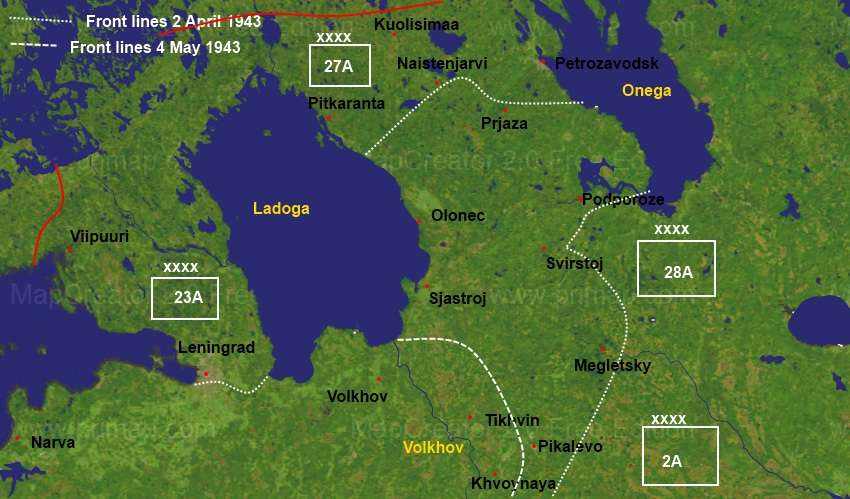
On the isthmus itself, two exhausted armies remained locked in mortal combat. The Germans tried to relieve the steadily increasing pressure from 27 Army by counterattacking at Pitkaranta on 5 April and at Naistenjarvi on the 9th. By the 13th both attempts had failed, this time with heavy German and relatively light Soviet losses.
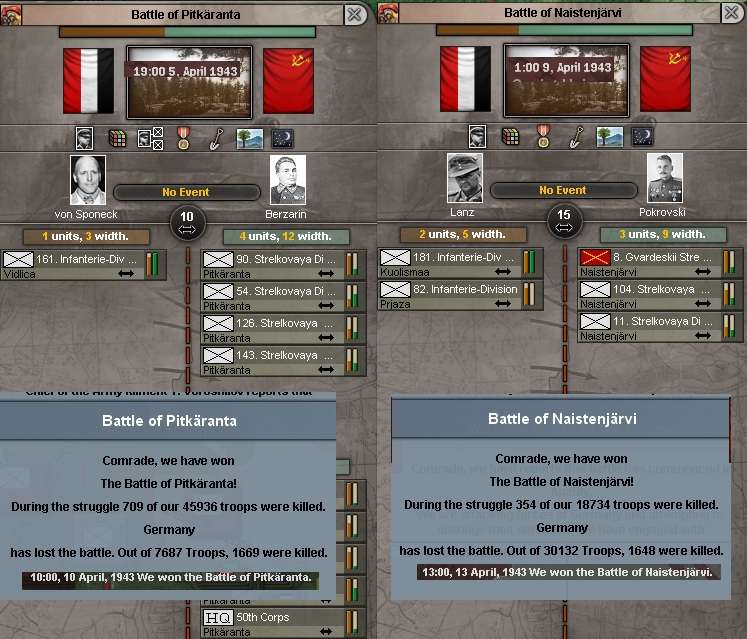
Their fate was sealed when elements of 28 Army cleared the last German troops from Sjastroj on 11 April and held off the inevitable counterattack on by the 17th. In both actions, German desparation to break open the Soviet pocket led them to attacking with no proper preparations, and with that, falling easy prey to ambushes and swift counterstrokes.
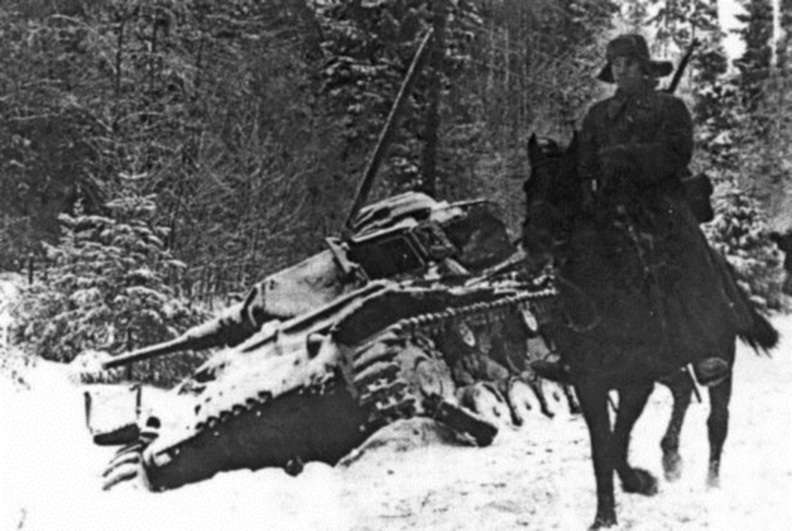
(elements of 6 Cavalry Division move past a destroyed German tank)
Even before the German relief effort was abandoned the first surrenders at Podporoze on 13 April were followed by the surrender of almost 32,000 (including the remnants of 5 Heavy Armour) at Prjaza on the 19th.
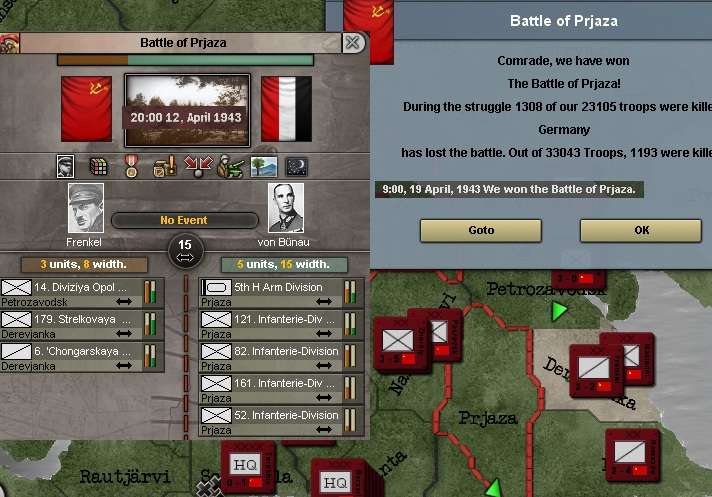
Finally, 181 Infantry surrendered at Kuolismaa after trying to flee across the Finnish border on the 20th.
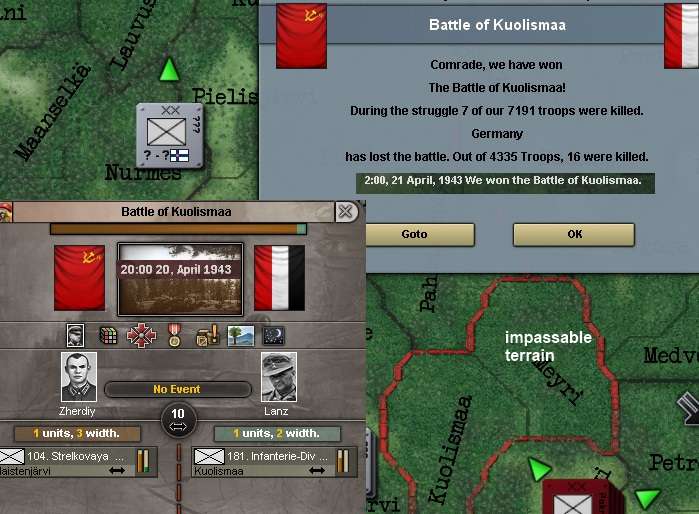
With this, the guns finally fell silent on the Ladoga-Onega Isthmus. By the 19th, Stavka was already redeploying units for future operations. 2 Cavalry Corps began the long journey to the Black Sea to take part in the forthcoming Balkan Operations and 50 Rifle Corps was redeployed to reinforce the Soviet lines at Smolensk.
In an attempt to exploit these victories and complete the relief of Leningrad, Stavka ordered 28 and 2 Armies to smash through the 'Volkhov Line'. Both sides were exhausted and the Soviet logistic system had effectively collapsed as trucks struggled with the spring muds across roads blown to pieces in the brutal winter battles.
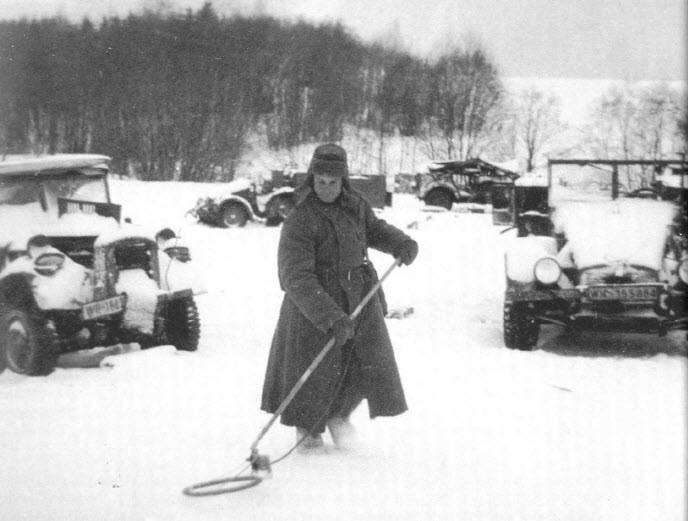
(mine clearing behind the lines, a necessary task if the logistical network was to be repaired)
The battles, centred on Pikalevo, Khvoynava and Tikhvin all lasted from mid-April into May.
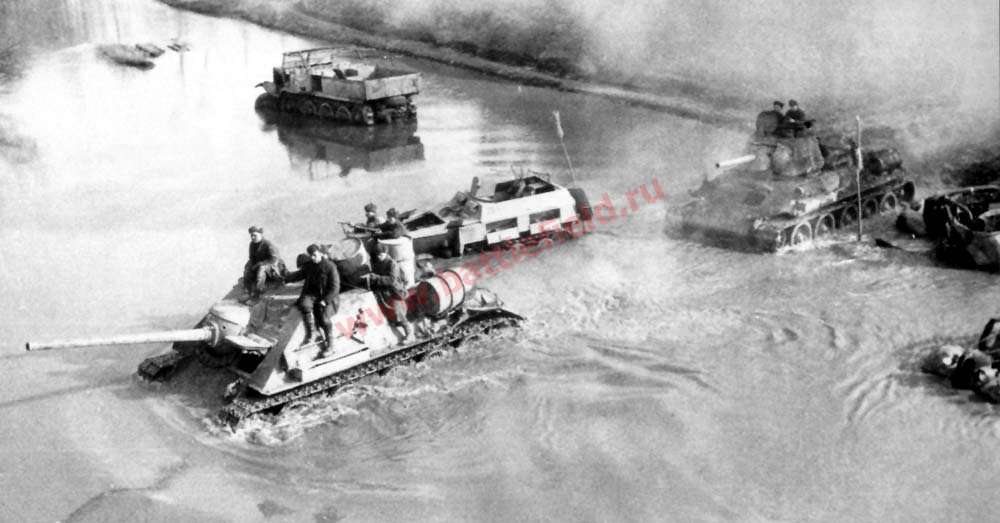
(SU-85s attached to 98 Rifle Division forcing the line of the Volkhov)
The Germans were not content to passively defend and struck hard at the junction between the two armies at Pikalevo. Exhausted after the winter battles and desparately short of munitions, the Rifle Divisions found themselves caught up on the German defense lines and trying to fend off a major counterattack.
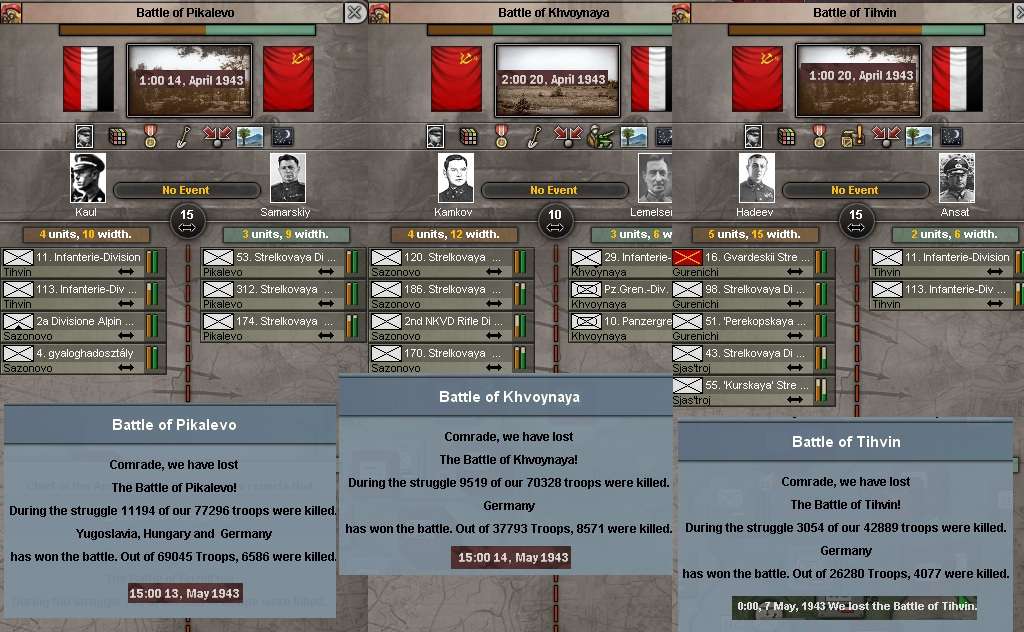
Finally by 13 May, Stavka authorised a retreat at Pikalevo and a suspension of the wider offensive.
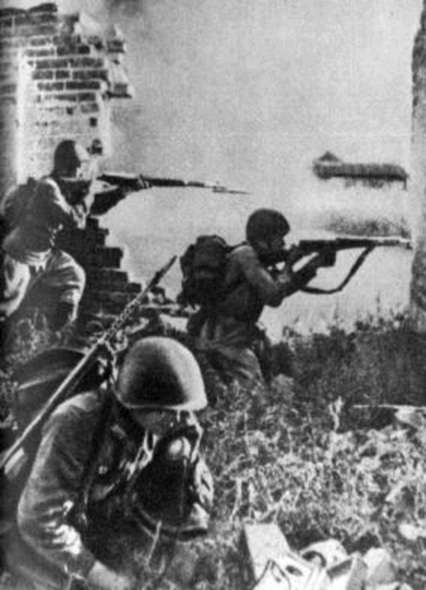
(Soviet defense lines at Pikalevo)
Soviet losses exceeded 23,500 in these battles alone. Effort was put into rebuilding the supply network before the next attempt to relieve Leningrad was undertaken.
Overall the Soviet winter offensive in the North had had successes. The German salient at the Rybinsk reservoir was a distant memory, the Kalinin Front had driven 100-150 kms west and, most importantly, Leningrad's supply lines were secure. However, it had been characterised all to often by a willingness to engage in brutal attritional battles leading to massive Soviet losses.
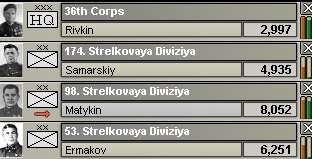
(38 Rifle Corps, 2 Army as of 4 May, typical of the Soviet formations on this sector)
The contrast to the successes of Operation Saturn were clear, and the political implications reverberated into the post-war era.
One argument was that Mars, and the related Ladoga Battles, was an essential prelude to driving the Wehrmacht from the USSR. The Germans suffered irreplaceable losses and by the late Spring were firmly on the defensive. All that was left to the Red Army was to find the weak spot in their defense lines. The counter view was not to dispute the overall outcome, but to point to battles such as the Volkhov Line, Megletsky-Marinskoye and, worst of all, Shitska Ostrov where Soviet losses could not be justified.
In the meantime, almost unremarked, 29 corps was making steady progress towards liberating Murmansk. By early May, Soviet troops had moved past Kandalaska and were pressing in on the German lines at Murmansk. At the start of the campaign some 50,000 (mostly Bulgarian) axis forces had been isolated in Karelia. By 5 May, less than 25,000 remained to defend Murmansk and 22,000 prisoners had been taken at Ponca (where again pressure had been placed on Finland to close the border crossings) and at Kolvitskoye.
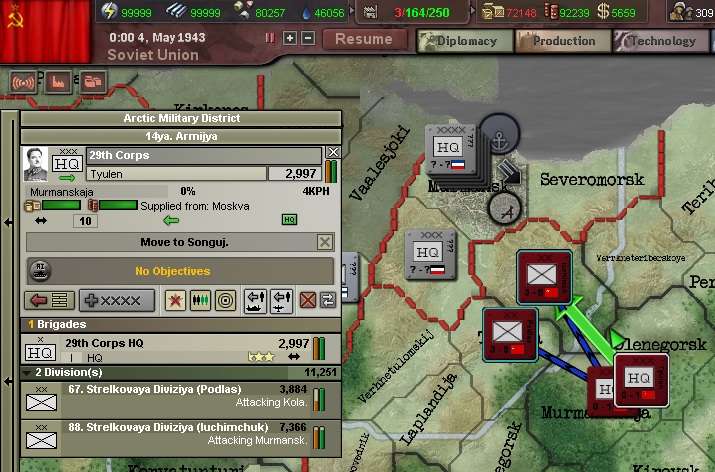
(Position before final Soviet assault on Murmansk)
In total, the casualty lists for April followed the usual depressing format. In the Ladoga batttles 34,582 Soviet, 34.142 German, 2,342 of their allies had lost their lives. From the Soviet perspective, this was justified by the 41,815 Prisoners of War and the destruction of another German Heavy Armour division. On the drive to Murmansk there had been 1,888 Soviet, 2,938 Axis casualties and a further 22,094 POWs.

(4 May)
Gameplay note
Bit of advice - don't SR divisions out of the front line (they take the supply with them), so once I sent 50 corps south, and a few other units, they stripped all the supply away from my line on the Volkhov - I hadn't expected this, hence the long and bloody battles.
The final acts of the 1942-3 winter battles were carried out on the often contested region around Lake Ladoga.

On the isthmus itself, two exhausted armies remained locked in mortal combat. The Germans tried to relieve the steadily increasing pressure from 27 Army by counterattacking at Pitkaranta on 5 April and at Naistenjarvi on the 9th. By the 13th both attempts had failed, this time with heavy German and relatively light Soviet losses.

Their fate was sealed when elements of 28 Army cleared the last German troops from Sjastroj on 11 April and held off the inevitable counterattack on by the 17th. In both actions, German desparation to break open the Soviet pocket led them to attacking with no proper preparations, and with that, falling easy prey to ambushes and swift counterstrokes.

(elements of 6 Cavalry Division move past a destroyed German tank)
Even before the German relief effort was abandoned the first surrenders at Podporoze on 13 April were followed by the surrender of almost 32,000 (including the remnants of 5 Heavy Armour) at Prjaza on the 19th.

Finally, 181 Infantry surrendered at Kuolismaa after trying to flee across the Finnish border on the 20th.

With this, the guns finally fell silent on the Ladoga-Onega Isthmus. By the 19th, Stavka was already redeploying units for future operations. 2 Cavalry Corps began the long journey to the Black Sea to take part in the forthcoming Balkan Operations and 50 Rifle Corps was redeployed to reinforce the Soviet lines at Smolensk.
In an attempt to exploit these victories and complete the relief of Leningrad, Stavka ordered 28 and 2 Armies to smash through the 'Volkhov Line'. Both sides were exhausted and the Soviet logistic system had effectively collapsed as trucks struggled with the spring muds across roads blown to pieces in the brutal winter battles.

(mine clearing behind the lines, a necessary task if the logistical network was to be repaired)
The battles, centred on Pikalevo, Khvoynava and Tikhvin all lasted from mid-April into May.

(SU-85s attached to 98 Rifle Division forcing the line of the Volkhov)
The Germans were not content to passively defend and struck hard at the junction between the two armies at Pikalevo. Exhausted after the winter battles and desparately short of munitions, the Rifle Divisions found themselves caught up on the German defense lines and trying to fend off a major counterattack.

Finally by 13 May, Stavka authorised a retreat at Pikalevo and a suspension of the wider offensive.

(Soviet defense lines at Pikalevo)
Soviet losses exceeded 23,500 in these battles alone. Effort was put into rebuilding the supply network before the next attempt to relieve Leningrad was undertaken.
Overall the Soviet winter offensive in the North had had successes. The German salient at the Rybinsk reservoir was a distant memory, the Kalinin Front had driven 100-150 kms west and, most importantly, Leningrad's supply lines were secure. However, it had been characterised all to often by a willingness to engage in brutal attritional battles leading to massive Soviet losses.

(38 Rifle Corps, 2 Army as of 4 May, typical of the Soviet formations on this sector)
The contrast to the successes of Operation Saturn were clear, and the political implications reverberated into the post-war era.
One argument was that Mars, and the related Ladoga Battles, was an essential prelude to driving the Wehrmacht from the USSR. The Germans suffered irreplaceable losses and by the late Spring were firmly on the defensive. All that was left to the Red Army was to find the weak spot in their defense lines. The counter view was not to dispute the overall outcome, but to point to battles such as the Volkhov Line, Megletsky-Marinskoye and, worst of all, Shitska Ostrov where Soviet losses could not be justified.
In the meantime, almost unremarked, 29 corps was making steady progress towards liberating Murmansk. By early May, Soviet troops had moved past Kandalaska and were pressing in on the German lines at Murmansk. At the start of the campaign some 50,000 (mostly Bulgarian) axis forces had been isolated in Karelia. By 5 May, less than 25,000 remained to defend Murmansk and 22,000 prisoners had been taken at Ponca (where again pressure had been placed on Finland to close the border crossings) and at Kolvitskoye.

(Position before final Soviet assault on Murmansk)
In total, the casualty lists for April followed the usual depressing format. In the Ladoga batttles 34,582 Soviet, 34.142 German, 2,342 of their allies had lost their lives. From the Soviet perspective, this was justified by the 41,815 Prisoners of War and the destruction of another German Heavy Armour division. On the drive to Murmansk there had been 1,888 Soviet, 2,938 Axis casualties and a further 22,094 POWs.

(4 May)
Gameplay note
Bit of advice - don't SR divisions out of the front line (they take the supply with them), so once I sent 50 corps south, and a few other units, they stripped all the supply away from my line on the Volkhov - I hadn't expected this, hence the long and bloody battles.
What makes least sense of this, is that Finland is still neutral when it 'could' decide the end of the war and help Germany and gain Karjala back.
More random than the German AI, I say.
More random than the German AI, I say.
Somebody should teach the AI that. I bet the Germans are routinely creating weak spots this way.Gameplay note
Bit of advice - don't SR divisions out of the front line (they take the supply with them).
Oh, and epic read, seriously. Maybe not squirrels from hell, but still.
This is true. The AI uses SR a lot, so its supply lines are often distorted.Somebody should teach the AI that. I bet the Germans are routinely creating weak spots this way.
You finally have a secure overland supply route to Leningrad. That has to be worth something. Perhaps not over 36,000 dead Soviets, but something at least... And you tidied up the lines at Murmansk, which is aesthetically pleasing, if nothing else.  Also a great job on culling those German/Axis divisions - every single one brings their day of defeat a tiny bit closer.
Also a great job on culling those German/Axis divisions - every single one brings their day of defeat a tiny bit closer.
How many divisions does this free up? Enough to compensate for all the losses in the South?
Great picture of the SU-85 and T-34: I love the image of the Soviet hardware fording that river (?), with leftover bits of German stuff discarded haphazardly.
How many divisions does this free up? Enough to compensate for all the losses in the South?
Great picture of the SU-85 and T-34: I love the image of the Soviet hardware fording that river (?), with leftover bits of German stuff discarded haphazardly.
why won't you replace Voroshilov with some other person more competent to lead the army? 
More Germans in your pocket. And most of the Bulgarian army, it seems. I'll bet they weren't expecting to be sent to Murmansk.
At least in this sector you've shortened your lines. That probably helps the German defence too, but once you can get the positions sorted out there's scope to transfer a large contingent to the Ukraine, where there's more scope for battles that aren't frontal slogging matches in difficult terrain.
At least in this sector you've shortened your lines. That probably helps the German defence too, but once you can get the positions sorted out there's scope to transfer a large contingent to the Ukraine, where there's more scope for battles that aren't frontal slogging matches in difficult terrain.
What makes least sense of this, is that Finland is still neutral when it 'could' decide the end of the war and help Germany and gain Karjala back. More random than the German AI, I say.
I agree, and going back and checking, the Germans asked them, and their neutrality/threat would have allowed it, if Finland had joined I'd lost Leningrad and I think the northern sector would have been an even longer stalemate than it has been.
Somebody should teach the AI that. I bet the Germans are routinely creating weak spots this way.
Oh, and epic read, seriously. Maybe not squirrels from hell, but still.
This is true. The AI uses SR a lot, so its supply lines are often distorted.
Aye, it really made it clear to me how much of a mess of your supply SR can make (on a localised level), I came close to a very large defeat till the supply to the units on the Volkhov sorted itself out again.
Keep pushing, germans are fading away
... but as in the next post, there are still an awful lot of them ...
You finally have a secure overland supply route to Leningrad. That has to be worth something. Perhaps not over 36,000 dead Soviets, but something at least... And you tidied up the lines at Murmansk, which is aesthetically pleasing, if nothing else.Also a great job on culling those German/Axis divisions - every single one brings their day of defeat a tiny bit closer.
How many divisions does this free up? Enough to compensate for all the losses in the South?
Great picture of the SU-85 and T-34: I love the image of the Soviet hardware fording that river (?), with leftover bits of German stuff discarded haphazardly.
I've now effectively have 27 Army in reserve (it'll take 3-4 weeks to recover) but for the first time in a long time I have a large formation I can chose what to do with.
Looking at that river scene gives the strong impression that something unpleasant (if you're a German soldier) has just happened.
why won't you replace Voroshilov with some other person more competent to lead the army?
He's actually quite useful, gives a -10% on supply needs which frees up IC for other things.
More Germans in your pocket. And most of the Bulgarian army, it seems. I'll bet they weren't expecting to be sent to Murmansk.
At least in this sector you've shortened your lines. That probably helps the German defence too, but once you can get the positions sorted out there's scope to transfer a large contingent to the Ukraine, where there's more scope for battles that aren't frontal slogging matches in difficult terrain.
What I do over the next couple of months is a sequential shift of forces south, some from the north to Smolensk and then others into the Ukraine. For the first time, the Ukraine is the key sector in 1943.
Mrr... Why haven't you already got to Berlin
on me way ... just the German AI objects ...
Preparing for the summer offensives
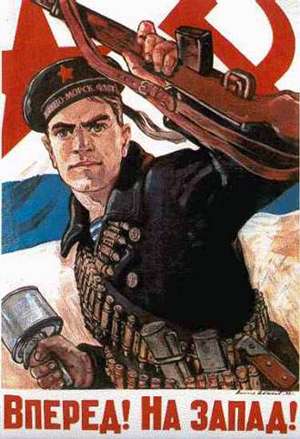
(forward to the west).
The end of the 1942-3 winter/spring battles can be seen as the pivotal moment in the Great Patriotic War. Again the RKKA had not landed a decisive blow and the Germans were still capable of offensive action of their own. In terms of terrain taken, in particular, the gains appear minimal.
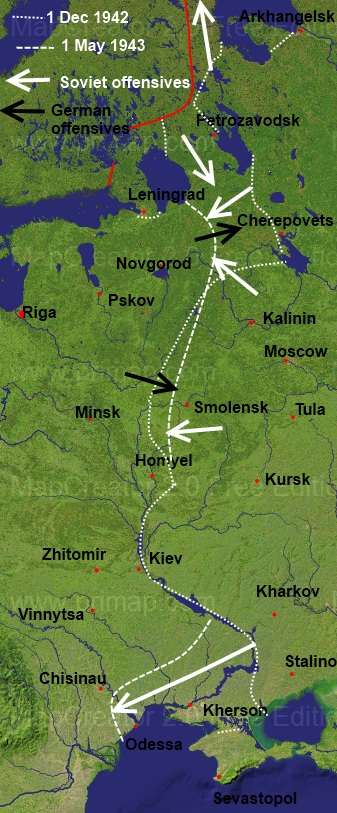
However, in terms of losses the Wehrmacht had been badly damaged and had lost a number (including 3 Tiger Divisions) of irreplaceable formations.
Overall, the Germans and their allies still outnumbered the Red Army by 2.1 million to 1.7 million.

However, almost 600,000 of their manpower was tied down in the West, re-organising in Germany or trying to supress Soviet and Polish partisans.
Both armies also bore the scars of the winter battles. The axis divisions were 600,000 below their notional complement and the Soviets 300,000.
On the Western Axis, the front can be divided into two blocks.
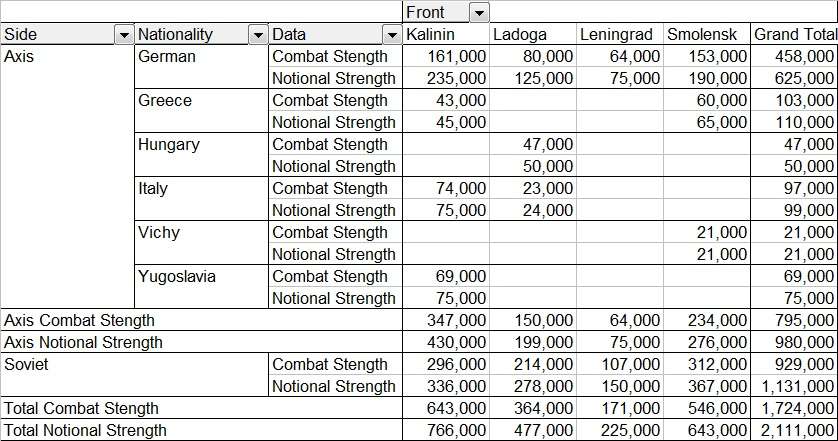
Around Leningrad and Ladoga, the Soviets now had the advantage of 3:2 in numbers. On the rest of the front, numbers were equal (even if 1/3 axis soldiers were not German). This balance was all the more worrying as the bulk of the German Panzer forces remained in this sector:

The detailed Soviet OOB was:
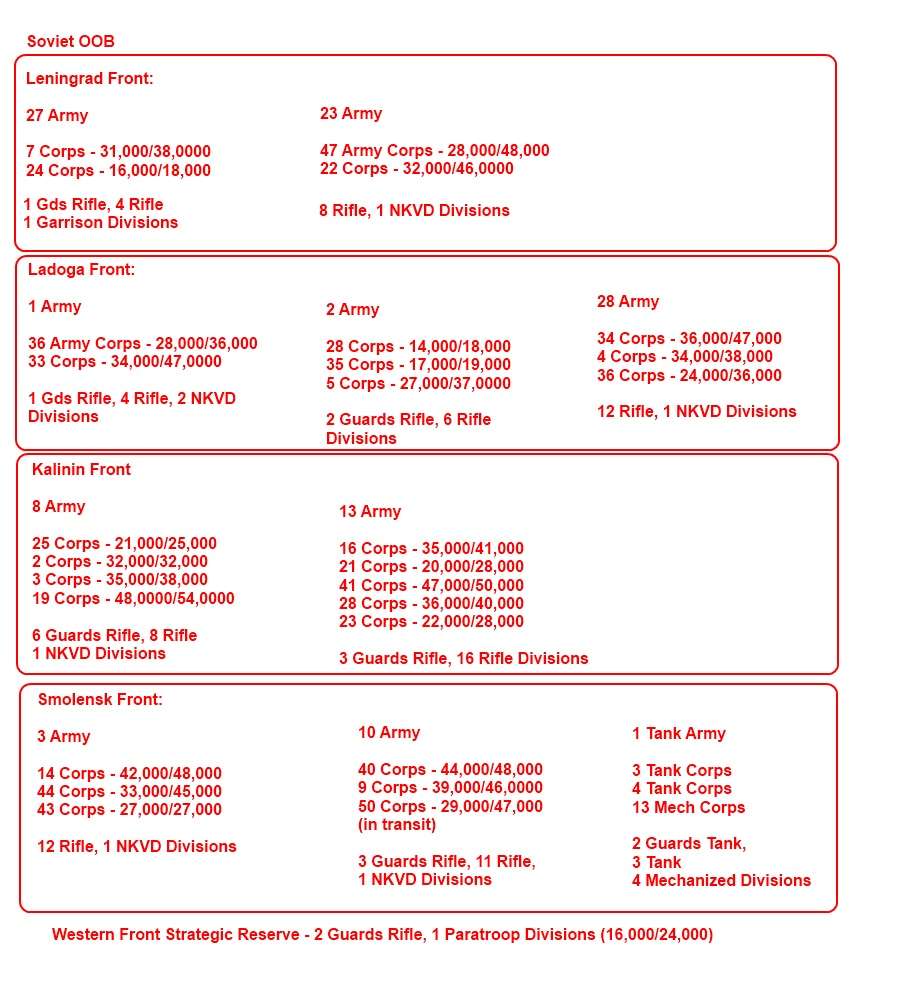
Bearing in mind the recent German offensive at Smolensk, Stavka wished to redeploy 1 Tank to the Ukraine but did not dare do so till it could be replaced. The fear remained of a renewed German offensive that could yet threaten Moscow.
This led Stavka on the Western Axis to propose a two stage plan for the early summer. To destroy the Germans at Leningrad and then redeploy substantial elements of the Ladoga Front to Smolensk. At that stage, an offensive aimed at liberating Minsk could be started.
In the Ukraine, front line combat numbers were roughly equal.
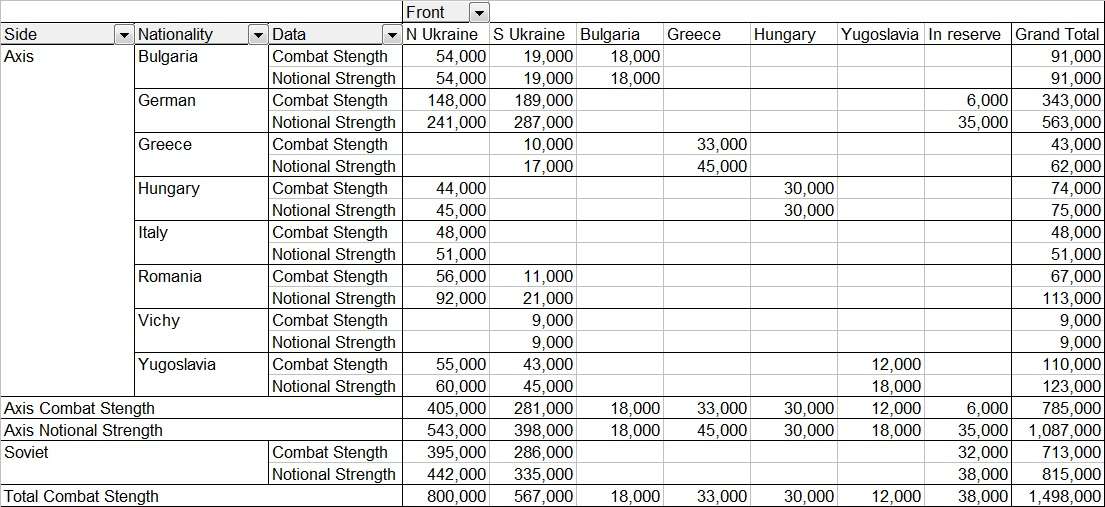
However, this ignores the extent that many German divisions had been badly disrupted in the course of Saturn or that, with the Odessa salient, the Red Army had a strategically dominant position. Also on this sector, the Soviets had superiority in terms of armour.
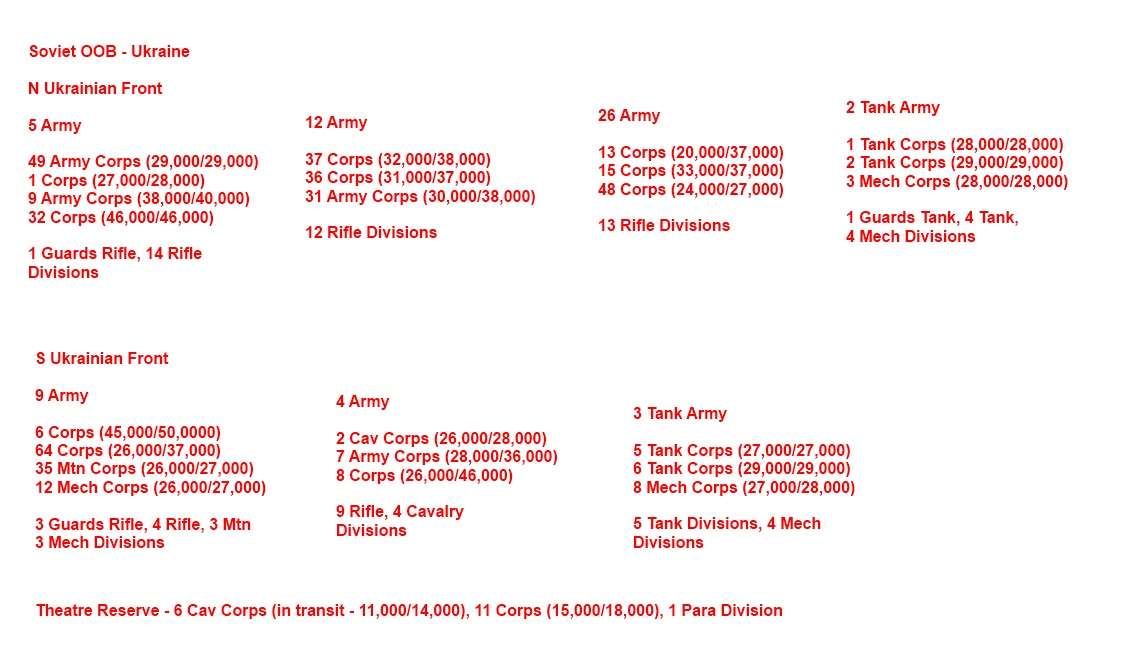

In addition to forces already in theatre, analysis of contemporary Soviet records and captured German archives confirms that up to mid-1943 the Germans left substantial Panzer forces in the west. After the sucess of Pobeda these were transferred to the Ukraine and took part in the autumn battles along the Vistula and the Carpathian passes.

(forward to the west).
The end of the 1942-3 winter/spring battles can be seen as the pivotal moment in the Great Patriotic War. Again the RKKA had not landed a decisive blow and the Germans were still capable of offensive action of their own. In terms of terrain taken, in particular, the gains appear minimal.

However, in terms of losses the Wehrmacht had been badly damaged and had lost a number (including 3 Tiger Divisions) of irreplaceable formations.
Overall, the Germans and their allies still outnumbered the Red Army by 2.1 million to 1.7 million.

However, almost 600,000 of their manpower was tied down in the West, re-organising in Germany or trying to supress Soviet and Polish partisans.
Both armies also bore the scars of the winter battles. The axis divisions were 600,000 below their notional complement and the Soviets 300,000.
On the Western Axis, the front can be divided into two blocks.

Around Leningrad and Ladoga, the Soviets now had the advantage of 3:2 in numbers. On the rest of the front, numbers were equal (even if 1/3 axis soldiers were not German). This balance was all the more worrying as the bulk of the German Panzer forces remained in this sector:

The detailed Soviet OOB was:

Bearing in mind the recent German offensive at Smolensk, Stavka wished to redeploy 1 Tank to the Ukraine but did not dare do so till it could be replaced. The fear remained of a renewed German offensive that could yet threaten Moscow.
This led Stavka on the Western Axis to propose a two stage plan for the early summer. To destroy the Germans at Leningrad and then redeploy substantial elements of the Ladoga Front to Smolensk. At that stage, an offensive aimed at liberating Minsk could be started.
In the Ukraine, front line combat numbers were roughly equal.

However, this ignores the extent that many German divisions had been badly disrupted in the course of Saturn or that, with the Odessa salient, the Red Army had a strategically dominant position. Also on this sector, the Soviets had superiority in terms of armour.


In addition to forces already in theatre, analysis of contemporary Soviet records and captured German archives confirms that up to mid-1943 the Germans left substantial Panzer forces in the west. After the sucess of Pobeda these were transferred to the Ukraine and took part in the autumn battles along the Vistula and the Carpathian passes.

